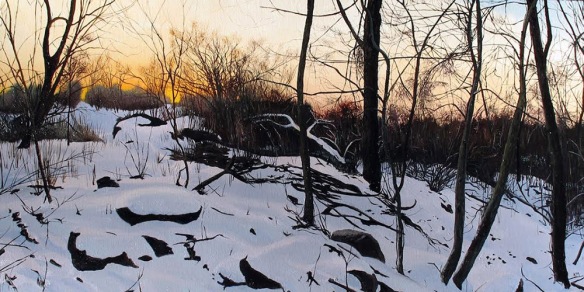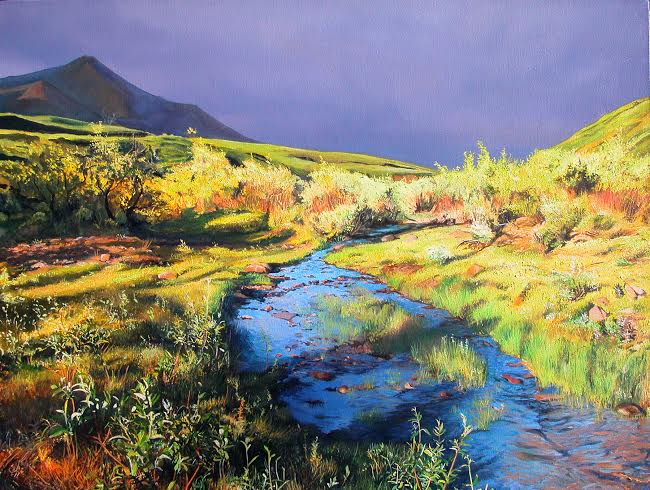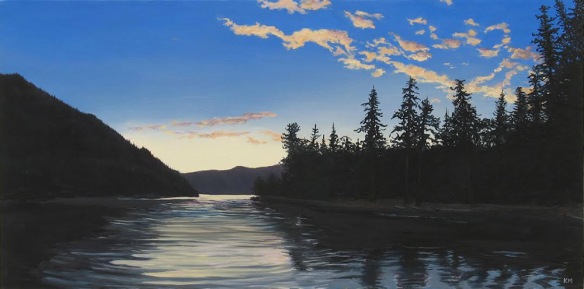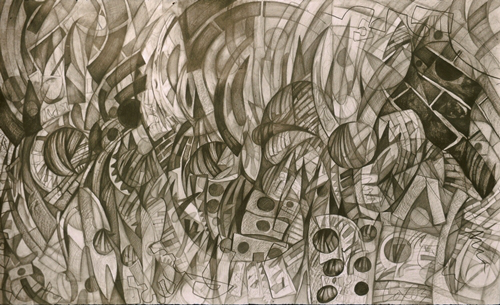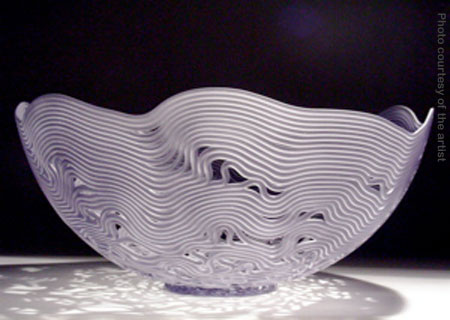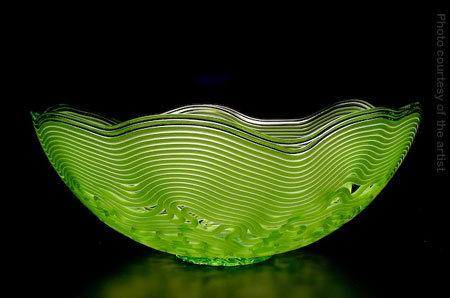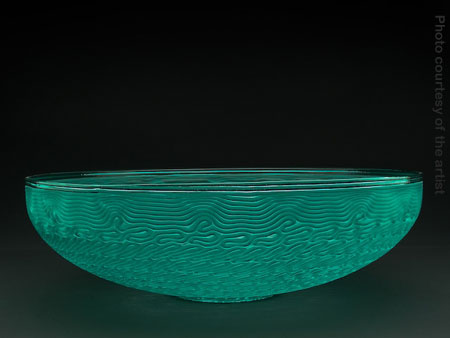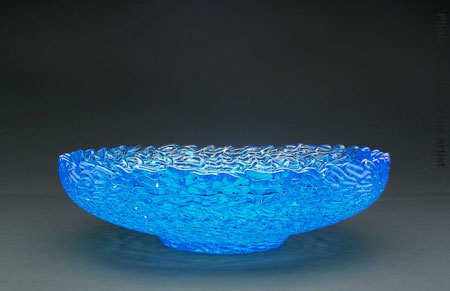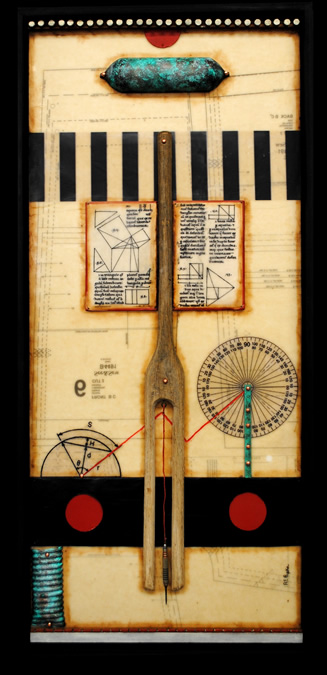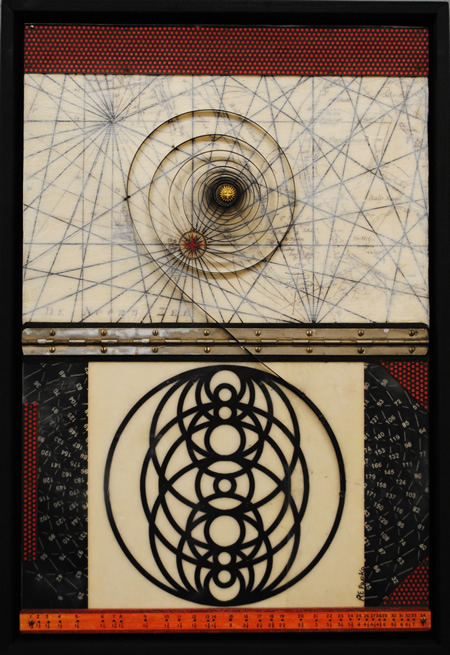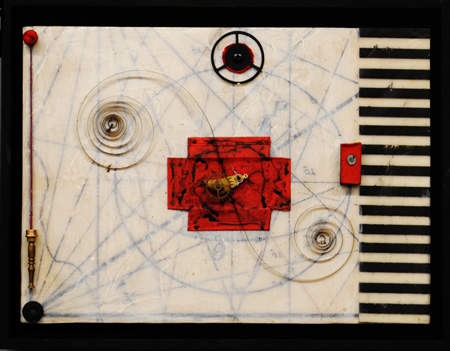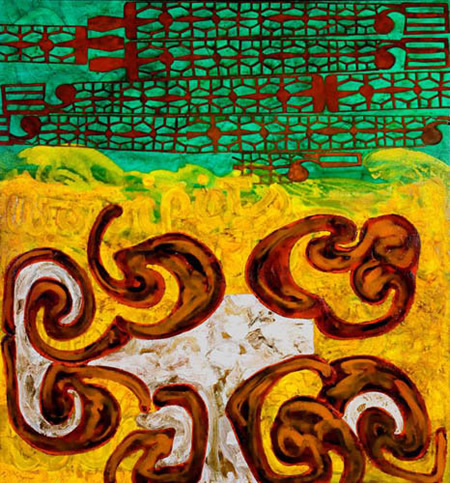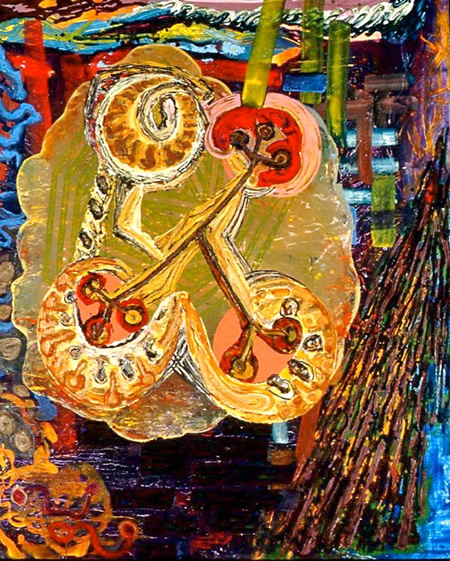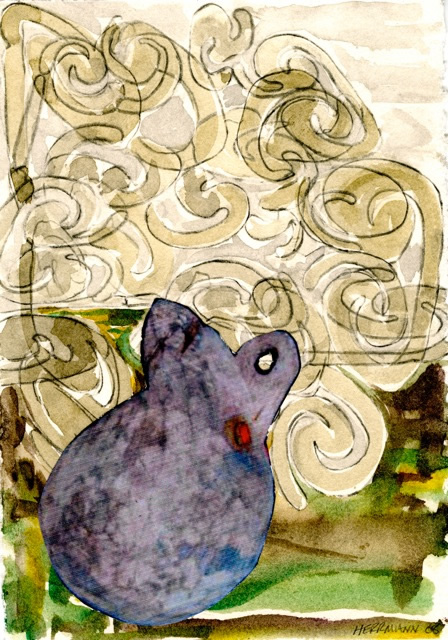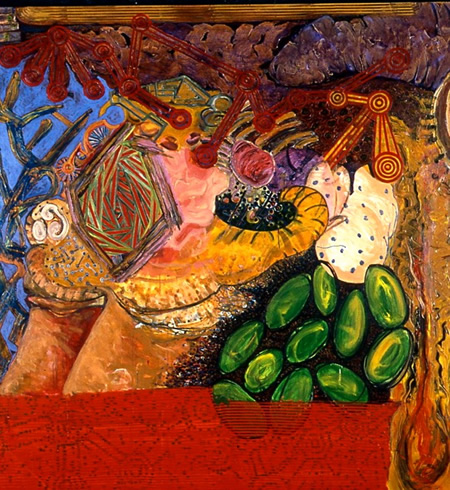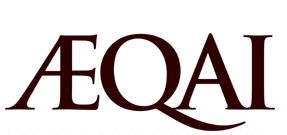
November 19th, 2016 | Published in October/November 2016
Depending on where you stand when you view them, Kevin Muente’s landscapes can be two different paintings. When seen from a distance, they initially appear to be works of almost photographic realism. When you get close to the paintings and notice his finely detailed brush strokes, the formal composition of the work dissolves. Forest trees and undergrowth, flowing water, fields of snow, twilight sky become abstracted lines, forms, and colors. It turns out the paintings actually exist somewhere between these two extremes. The fluctuating quality of Kevin Muente’s landscape painting is beautifully on display in “Life in the Woods” at Marta Hewett Gallery, where it will run through November 27,2016.
The exhibition includes eleven large oil on canvas landscapes and several smaller works, some of which are studies for the larger landscapes. Muente paints scenes he has discovered during his time in woods from Appalachia to Alaska. His compositions are carefully balanced. Many of these scenes are captured at twilight, when the sky casts a dramatic light. This light, at first glance, makes the paintings seem like enlarged photographs. Yet Muente works with such strong color contrasts that the components of his paintings—bodies of water, forest interiors, fields, mountains, sky—easily morph into abstract patterns and planes of pure color. He has reduced the elements of the natural settings from which he takes his inspiration to certain essentials of land, water, and sky. To portray these essentials, Muente pushes color beyond what it looks like in nature. The initial impression of realism evaporates the longer you study the canvases. When viewing his landscapes, you always come to the realization these are paintings, not photographs.
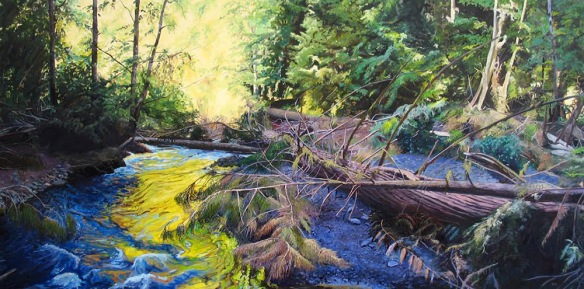
Barnes Creek, Olympic National Park.
In “Barnes Creek, Olympic National Park” the reflection of the setting sun makes the flowing water appear to be on fire. The brilliant blue, yellow, and green color scheme of the painting is very appealing to the eye. What saves this landscape from being too postcard pretty is the slight untidiness of nature. The creek is eroding its banks; the fallen trees show the effects of recent storm damage and natural decay. A clear, bright light illuminates this scene of fecundity and decomposition. The carefully chosen details are rendered realistically, but the limits on the visual details and the intense color palette make this a work of almost abstract beauty, more painterly than natural.

Pond Near Teklanika River.
In “Pond Near Teklanika River” the embankment of a pond with dense underbrush and a scattering of scraggly pine trees runs through the center of the canvas. This is a mirror image painting: the trees, mountains and sky above the embankment are reflected in the still pond seen in the lower section of the picture. Although it is daylight, there are storm clouds in the sky, so the light is muted and the colors of the painting are pale. There is scum on the pond and the trees are barren and windswept, but the water does not seem murky and the trees are almost too precisely placed. The most compelling aspect of the painting is its composition. The sky above the embankment and the reflecting water below divide the painting into three strong horizontal bands intersected by the jutting vertical lines of the trees. The work is a masterly example of Muente’s ability to lead the viewer’s eye into his paintings.
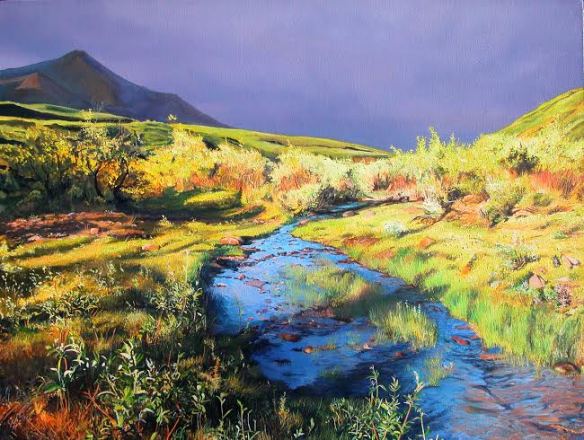
Storm over Sable Pass, Denali National Park.
In the lower left corner of “Storm over Sable Pass, Denali National Park” delicate high mountain vegetation is rendered in very fine detail. Each blade of grass, each leaf and bud on the plants is meticulously delineated. Above this close-up view of nature rises a landscape that culminates in a distant mountain peak and a dramatic purple sky. The painting demonstrates Muente’s ability to depict vast spaces on a relatively small canvas. The use of contrasting color in this painting is astonishing. Between the vivid blue of the creek water and the purple of the sky, the high mountain meadow is bright yellow. Storm clouds moving through western mountains can cause the sun to cast a light that makes colors seem brighter than they should be, shadows ominous, sky unnatural. Muente enhances this effect beyond what is seen in nature, making his real mountain pass seem ultimately unreal.

Winter Twilight.
“Winter Twilight” provides a cool contrast to “Storm Over Sable Pass, Denali National Park.” On a rocky hillside, scruffy brush and a few barren trees are silhouetted against a winter sky. There is little grandeur in this landscape. Color comes primarily from the golden disk of the setting sun and pale yellow light in the sky. Trees and rocks are seen mostly in shadow. The pure white snow is rendered so precisely it glistens. Muente lavishes great attention on the patterns created by barren branches of the trees and the pale light reflected in the drifting snow. The trees look awkward in their nakedness and the ground is littered with fallen branches, but the snow underneath, with delicate modulations of color, has a cold, flowing beauty. This is one of Muente’s most restrained landscapes
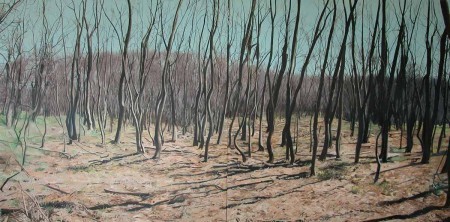
Dry Creek Bed
Kevin Muente has found inspiration for his landscapes in some of America’s great national parks. Dramatic natural scenes give his paintings power, but they also may limit how much his imagination comes into play in his work. The largest, and to my mind most interesting, painting in this show was inspired by a more modest setting, the woods near his house. “Dry Creek Bed” is a diptych with familiar elements: a composition of horizontal segments of sky and earth with a stand of barren trees casting shadows in a pale winter light. The colors are subdued, mostly tan and light blue. This painting is about the aesthetic pattern created by the trees, a pattern more abstract than realistic. The trees, which look almost as if they are dancing, command the viewer’s attention. Despite its enormous size, the work is relaxed. In this painting Muente seems less interested in enhancing a dramatic natural scene and more interested in giving free play to his imagination. Without question, Kevin Muente is one of the most technically skillful painters working in the Greater Cincinnati area today. It is intriguing to consider what he could produce if he follows the creative direction suggested by “Dry Creek Bed.”
–Daniel A. Burr
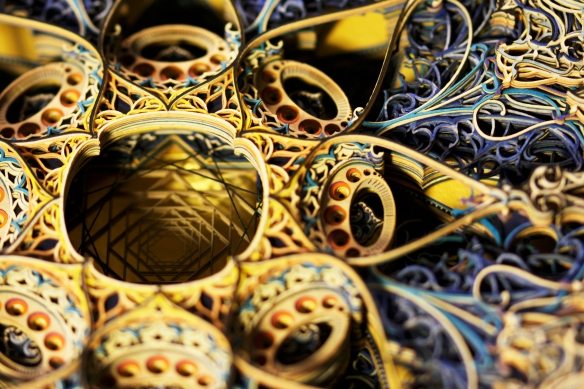
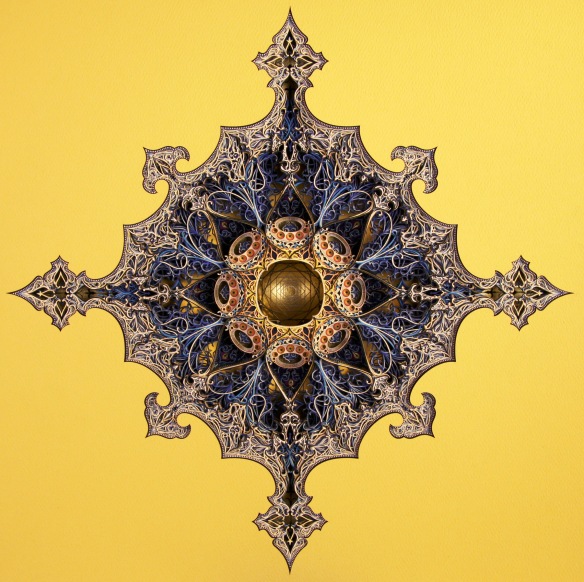 Images: (top) Kismet (detail), cut paper and gold leaf, 24”x24”, 2017. (bottom) Kismet, cut paper and gold leaf, 24”x24”, 2017. Courtesy of the Artist and Marta Hewett Gallery
Images: (top) Kismet (detail), cut paper and gold leaf, 24”x24”, 2017. (bottom) Kismet, cut paper and gold leaf, 24”x24”, 2017. Courtesy of the Artist and Marta Hewett Gallery


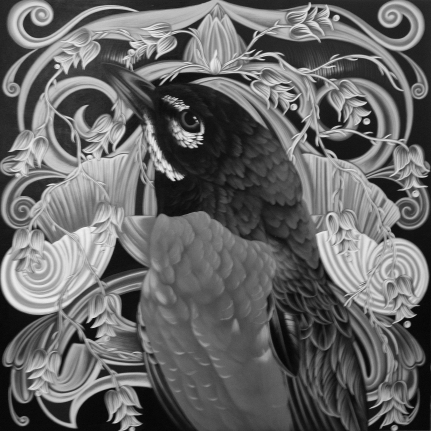 Americana #11 American Robin, 2014, 30″ x 30″, Acrylic on wood panel
Americana #11 American Robin, 2014, 30″ x 30″, Acrylic on wood panel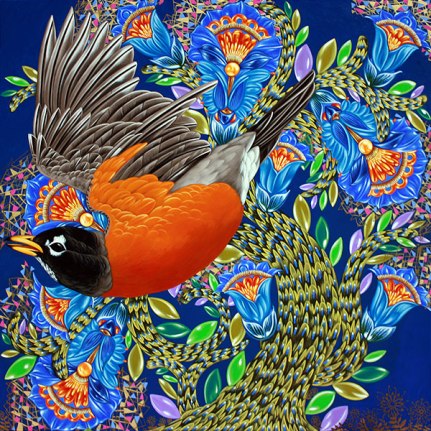
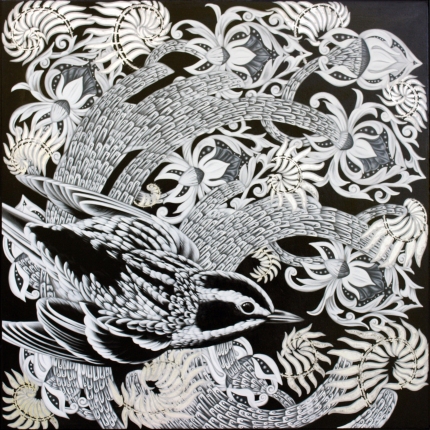 Exult #6 Warbler, 2016, 30″ x 30″, Acrylic on wood with silver leaf
Exult #6 Warbler, 2016, 30″ x 30″, Acrylic on wood with silver leaf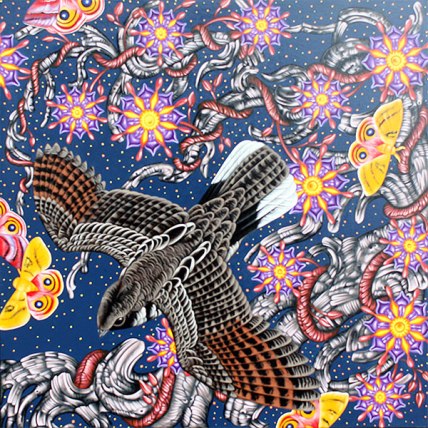 Exult #8 Whip-poor Will, New England Aster and Io Moth, 2016, 30″ x 30″, Acrylic on wood
Exult #8 Whip-poor Will, New England Aster and Io Moth, 2016, 30″ x 30″, Acrylic on wood 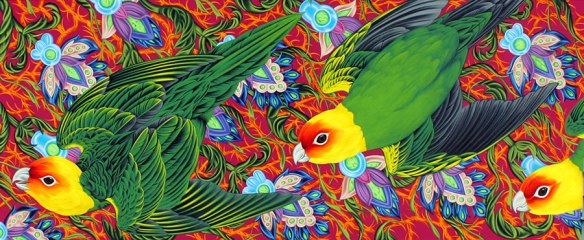
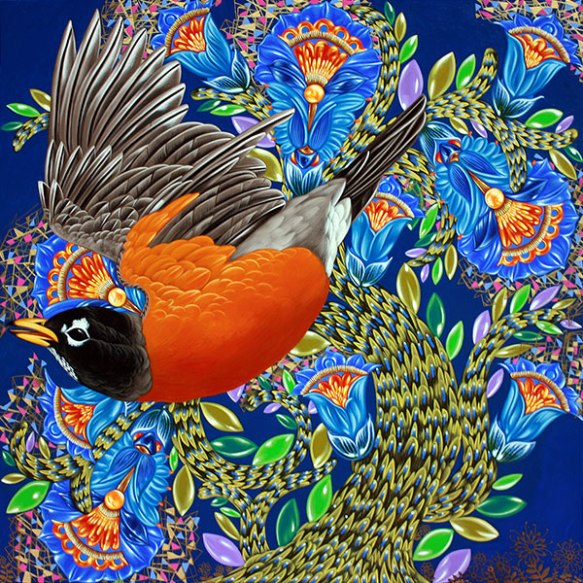
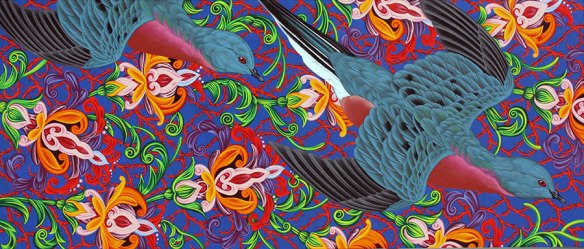






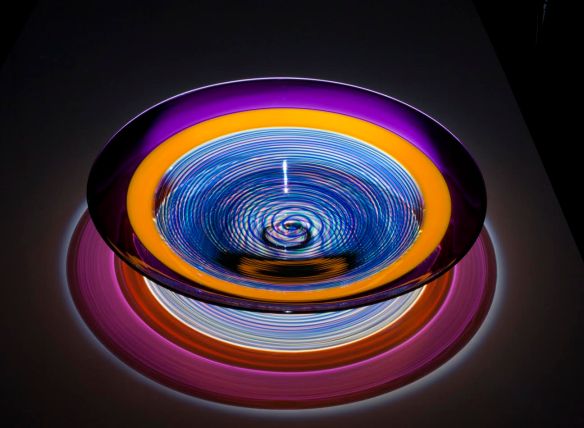
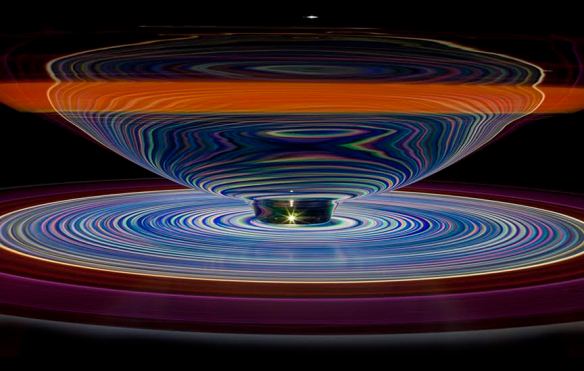 Images: Manic Carrot Twister, Blown glass, 6” x 26.5” diameter, Courtesy of the Artist and Marta Hewett Gallery
Images: Manic Carrot Twister, Blown glass, 6” x 26.5” diameter, Courtesy of the Artist and Marta Hewett Gallery